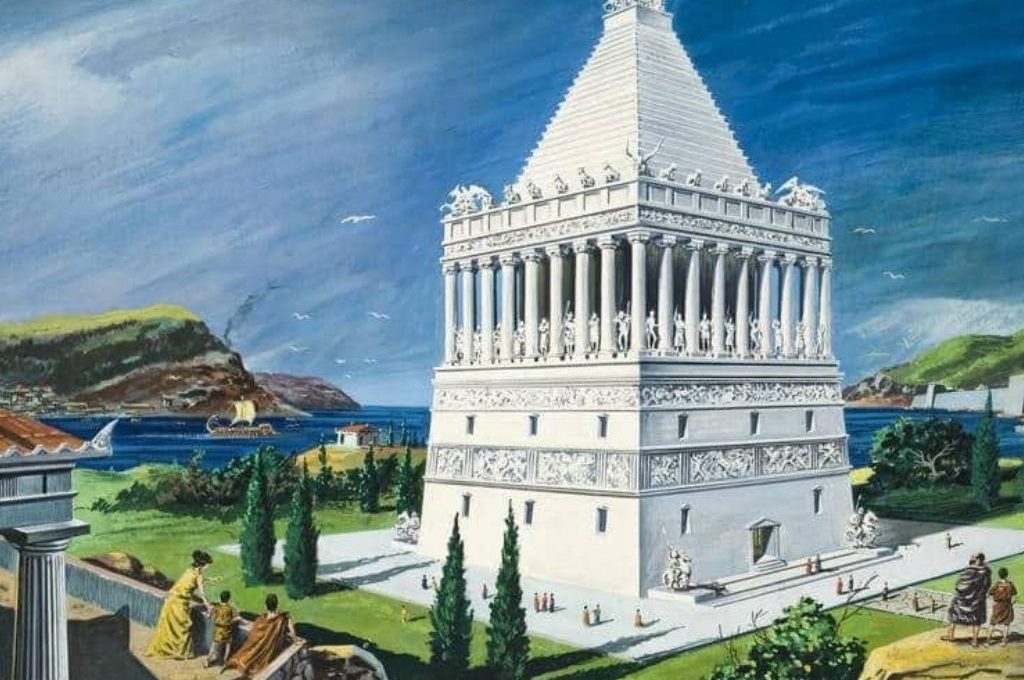The cover photo has been taken from Mausoleums.com.
Did you know that two of the Seven Wonders of the Ancient World are within the borders of present-day Turkey? And one of them is the Mausoleum at Halicarnassus. 👀
The Mausoleum at Halicarnassus is in Bodrum, one of Turkey’s famous vacation spots. One of the most exciting things about the Mausoleum at Halicarnassus is how it became the origin of the term “mausoleum” itself. The word has since been used to describe grand tombs and monuments around the world, but this one truly set the bar high.
🛎️ Reminder: To explore the Mausoleum at Halicarnassus with your digital tour guide, don’t forget to download Piri Guide! 😊
First Steps of the Monument
The Mausoleum at Halicarnassus is a monumental tomb. It is the tomb of a famous figure who once governed the region of Anatolia called “Caria”, Satrap Mausolus. The Mausoleum was built not after Mausolus’s death but during his lifetime, on his order. Mausolus wanted to immortalize himself and his dynasty with the structures and the tomb he had built. His desire was influential in determining the location of the Mausoleum. Mausolus built his tomb not on the highest point of the city but in the “centre”. This way, people would see the mausoleum from wherever they were in the city and remember Mausolus.
Satrap Mausolus ruled over Caria for 24 years. Unfortunately, he passed away in 353 BC before he could see the completion of his magnificent tomb. His sister and also his wife, Artemisia II, continued the construction process.
The Birth of the Mausoleum
We’ve talked about the history of the Mausoleum at Halicarnassus. Yet, we should remind you that you can find more on Piri Guide mobile app. Piri Guide detects your location, offers you the best travel routes, and starts telling you the hidden stories of wherever you are. All you have to do is to get your headphones or earbuds and follow the path at your own pace. Then, don’t set out for your trip before downloading the digital travel guide! 😊
Construction of the Mausoleum at Halicarnassus
No one who saw the Mausoleum at Halicarnassus when it was still standing has ever made a drawing of it! And even if someone did, unfortunately, it couldn’t survive until today. Information about the architecture of the mausoleum is based on two ancient sources. These sources belong to two Roman writers, Pliny the Elder and Vitruvius, who lived in the 1st century. But neither of them saw the mausoleum with their own eyes!
Although we do not know exactly what it looked like, we know that the best architects and sculptors of the time worked on the Mausoleum. Satyros from Paros and Pythius from Priene designed the Mausoleum. Four different sculptors worked on the four sides of the monument. These sculptors made reliefs on the podium friezes. In the reliefs, they depicted the battles of the Greeks with the Amazons or their internal conflicts.
Some even believe that the columns of the Artemis Temple in Ephesus inspired those of the mausoleum.
What’s Next?
The Mausoleum at Halicarnassus was later destroyed by natural causes such as earthquakes. In the late 15th century, the Knights of St. John came to Bodrum. They built Bodrum Castle, one of the city’s iconic structures, using the stones from the ruined Mausoleum. They even melted some parts to obtain the lime needed for the construction. Visitors to Bodrum Castle today can see some of the Mausoleum’s pieces on the walls.
But did you know there’s another place where you can see parts of the Mausoleum? British Museum in London! In the mid-19th century, archaeologist Charles Thomas Newton visited Bodrum. At that time, there were eight structures on the large terrace of the Mausoleum that were used as houses. Newton bought these structures, had them demolished, and started excavation work. Over 1700 artefacts were found during the 10-year excavation, some of which are on display at the British Museum. Among these artefacts is a horse head from the quadriga at the top of the Mausoleum and the giant statues of Mausolus and Artemisia.
Wanna explore Bodrum? Then, check out our Bodrum Travel Guide!

